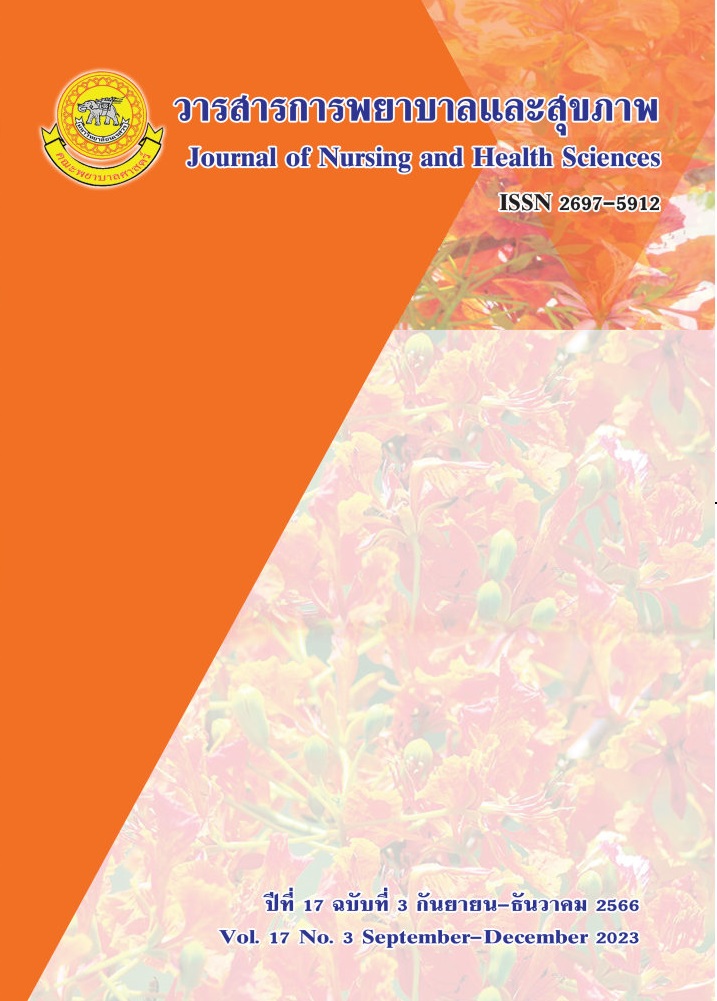Health deviation Self-care among patients with chronic obstructive pulmonary disease experienced acute exacerbations
Main Article Content
Abstract
The objective of this qualitative research was to study health deviation Self-care among patients with chronic obstructive pulmonary disease who experienced acute exacerbation. Tools that were used to collect data were in-depth interviews, non-participatory observation, and field notes. All the data were analyzed using Colaizzi’s method.
The results of this study can be explained in detail of six features: 1) avoiding factors that stimulate symptoms of dyspnea and are sub-divided into three categories including: stop smoking and avoid cigarette smoke, avoid dust, and avoid crowded places. 2) follow the health team instructions and are sub-divided into four categories including: breathing exercises, exercise, use of medication as directed, and attending an appointment. 3) prepare for emergencies and are sub-divided into two categories including: carry an inhaler, and prepare the inhaler. 4) There are ways to self-care for dyspnea and are sub-divided into three categories including: stop doing activities to reduce tiredness, use the inhaler when you have an exacerbation, and go to the hospital when you have breathlessness. 5) asking for help when you have more dyspnea and are sub-divided into three categories including: asking for help from close people, asking a friend for help, seeking help from government officials. 6) notice learn and prevent repetitive panting and are sub-divided into three categories including: seek help from government officials, and protect yourself from stimuli. And the contributing factors affecting self-care were hope for good health, living for loved ones as a driving force to continue living. And another factor is family, close people who help care for and provide support in self-care. The factors that hinder self-care include occupation and the surrounding environment.
The results of this study can be applied to the knowledge gained about self-care when deviating in the health of COPD patients who have experienced acute exacerbations and the results of the study were used as information for the development of the model caring for patients with chronic obstructive pulmonary disease who have experienced acute exacerbations.
Article Details

This work is licensed under a Creative Commons Attribution-NonCommercial-NoDerivatives 4.0 International License.
References
Berg, K., & Wright, J. L. (2016). The pathology of chronic
obstructive pulmonary disease: progress in the
th and 21st centuries. Archives of pathology &
laboratorymedicine, 140(12), 1423-1428.
Boonreung, J., Suwanno, J., Phonphet, C., Petsirasan,
R, & Thiamwong, L. (2017). Predictors of chronic
obstructive Pulmonary disease sever eacute
exacerbation. Thai Journal of Cardio- Thoracic
Nursing, 28(1). 111-128. [In Thai].
Global initiative for Chronic Obstructive Lung
Disease. (2023). Golbal Strategy for the diagnosis,
management, and prevention of chronic obstructive
pulmonary disease 2023 report. Retrieved April
, 2023, from https://goldcopd.org/wp-content/
uploads/2023/03/GOLD-2023-ver-1.3-17Feb 2023_
WMV.pdf
Guba E. G., & Lincoln. Y. S. (1989). Fourth generation
evaluation. Newbury Park, CA: Sage.
Halpin, D. M., Miravitlles, M., Metzdorf, N., & Celli, B.
(2017). Impact and prevention of severe e
xacerbations of COPD: a review of the evidence.
International journal of chronic obstructive
pulmonary disease, 12, 2891-2908.
Inchai, P., Jumniensuk, A., Durongdej, S., Sonthipho, P.,
Bandit, J., & Eimsaard, C. (2018). Self care
behaviors among elderly peoplewith chronic
diseases in Pamok District, Angthong Province.
Journal of the Department Services, 43(4),100-
[InThai].
Kamthong, S. (2019). Factors predicting acute exacerbation in patients with chronic obstructive
pulmonary disease. Master Thesis (Nursing),
Naresuan University, Phitsanulok. [In Thai].
Ko, F. W., Chan, K. P., Hui, D. S., Goddard, J. R.,
Shaw, J. G., Reid, D. W., & Yang, I. A. (2016).
Acute exacerbation of COPD. Respirology, 21(7),
-1165.
Lei, S., Li, M., Duan, W., Peng, C., Chen, P., & Wu, S.
(2020). The long-term outcomes of tobacco
control strategies based onthe cognitive intervention
for smoking cessation in COPD patients.
Respiratory medicine, 172, 1-6.
National Health Security official, (2020). NHSOAnnual
Report 2020.Retrieved April 1, 2023, fromhttps://
www.nhso.go.th/page/audit_annual.
Ngoenthae, D. (2017). Self-care experience of people
with chronic obstructive pulmonary disease
(COPD) exacerbation. Master Thesis (Nursing),
Mahidol University, Bangkok. [In Thai].
Orem, D.E. (2001). Nursing: concepts of practice
(6th ed.). St. Louis: Mosby.
Poko, S., Changmai, S., &Toskulkao, T. (2019). The
effects of hope promotion program on hope index
in stroke Patients during post-acute phase.
Nursing Journal of the Ministry of Public Health,
(3), 80-93. [In Thai].
Puttavichaidit, P., & Chinasote, Y.(2022) Outcome
evaluation of care among patients with chronic
obstructive pulmonary Disease in Luangphorpern
Hospital under the coronavirus disease 2019
(COVID-19) pandemic. Journal of Health and
Environmental Education, 7(4), 51-63. [In Thai].
Rodkantuk, E. (2017). Acute exacerbation symptoms
among patients with chronic obstructive pulmonary
disease, triggering factors, and management
strategies. Master Thesis (Nursing), Walailak
University,Nakhon SiThammarat. [In Thai].
Sripariwut, E.,Wanteeraprasert, A., Jitphiwngam, W., &
Pongcharoen, S. (2016). Common chronic diseases
internal medicine guidelines for diagnosis and
treatment.Phitsanulok: Naresuan University. [In Thai].
Thoracic Societyof Thailand under Royal Patronage,
(2022). Guidelines for the diagnosis and treatment
of chronicobstructive pulmonary disease 2022.
Bangkok: Phaphphimph. [InThai].
Tiraputpong,W., 2021. Cardiopulmonary rehabilitation.
Bangkok: ID digital print. [InThai].
Treewichar, W., Khungtumneam, K., & Buajalearn, H.
(2017). Guideline for management the acute
exacerbation at home by chronic obstructive
pulmonary disease: COPD patient. Journal of
The Royal Thai Army Nurses, 18(1), 216-221.
[InThai].
Uamtanee, A. (2016). Qualitative research innursing
(3nd ed.).Bangkok: Chulalongkorn University
Printing House. [InThai].
Uttaradit hospital. (2023). Uttaradit hospitalannual report
Uttaradit: Uttaradit hospital. [In Thai].
Vogelmeier, C. F., Roman-Rodriguez, M., Singh, D., Han,
M. K., Rodriguez-Roisin, R., & Ferguson, G. T.
(2020). Goals of COPD treatment: focus on
symptoms and exacerbations. Respiratory
medicine, 166, 1-7.
Wandao, Y., Chinnawong, T., Chalothorn, U.,
& Tipwong, A. (2018) The experience of
self-management in patients with uncontrolled
type 2 diabetes, Sadao Hospital, Sadao, Songkhla.
Songklanagarind Journal of Nursing, 38(3),
-64. [In Thai].
World Health Organization. (2022). Chronic obstructive
pulmonary disease (COPD). Retrieved March
, 2023. From https://www.who.int/news-room/
factsheets/detail/chronic-obstructive-pulmonarydisease-(copd).


